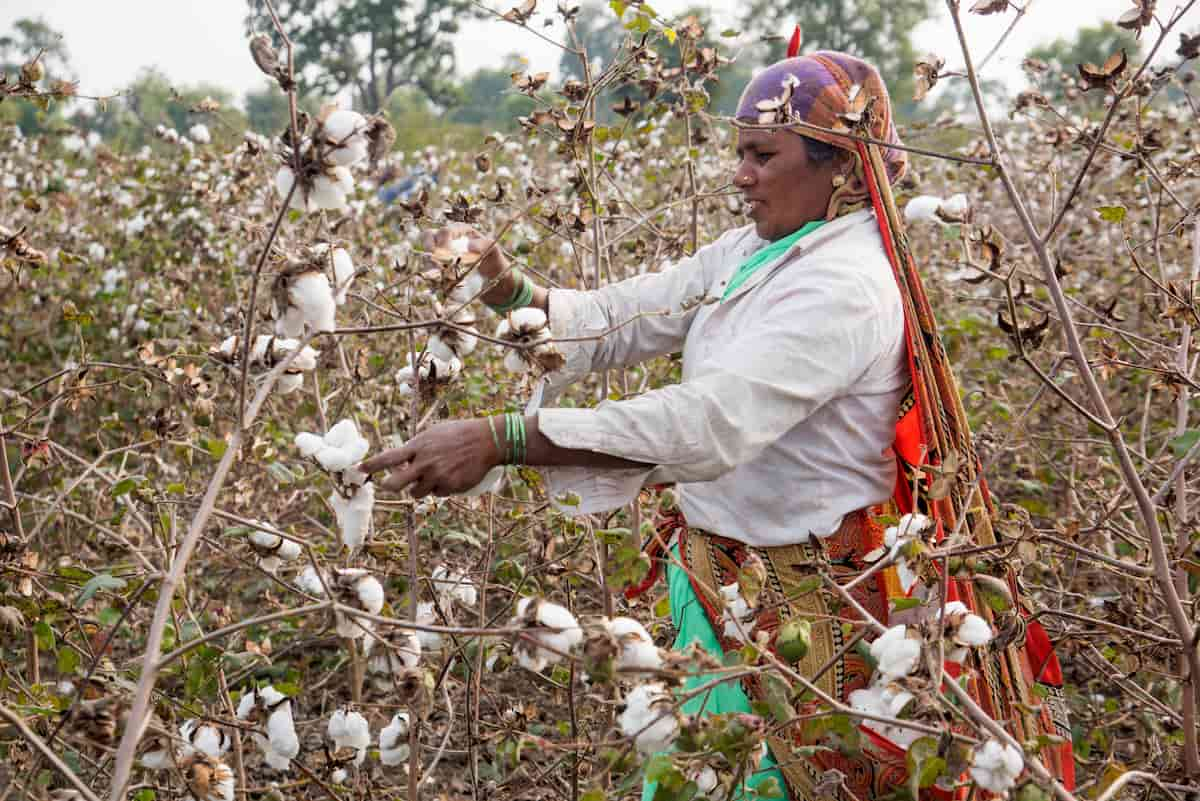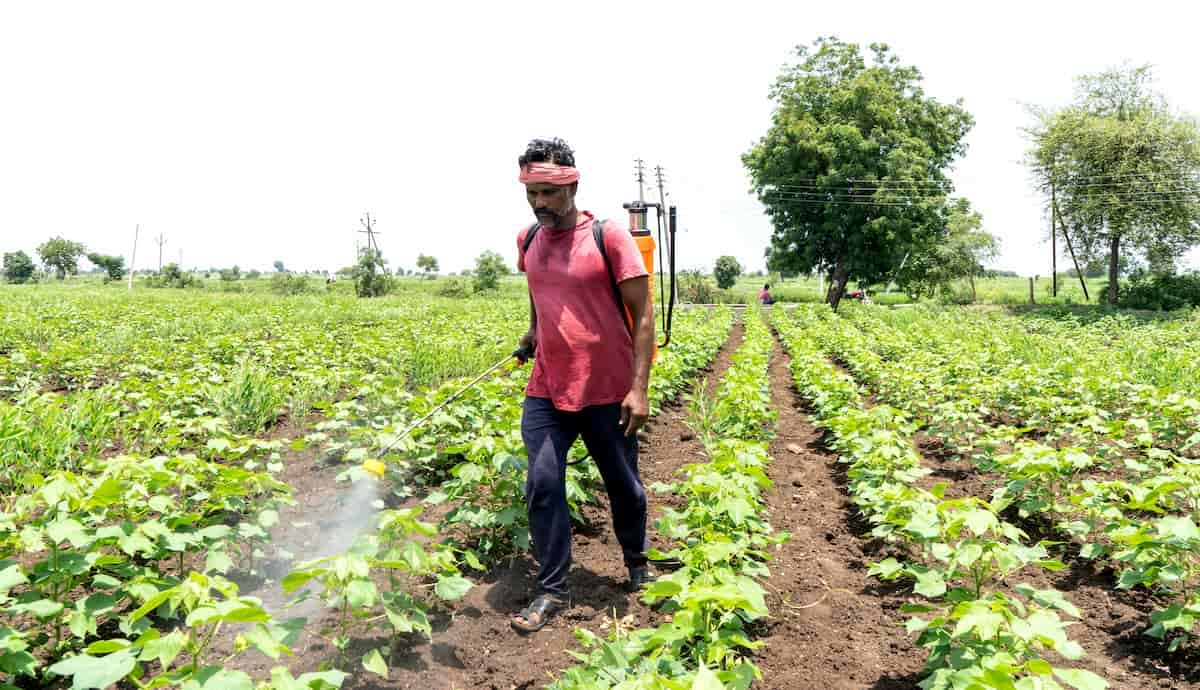Cotton is a widely cultivated crop valued for its fiber and seeds. One of the significant challenges faced by cotton farmers is Fusarium Wilt, a disease caused by the fungus Fusarium oxysporum f. sp. vasinfectum. This disease can result in significant financial losses and is persistent in the soil through chlamydospores and its association with the roots of various plants, including Cotton, non-cotton hosts, and resistant plants, as well as through contaminated seeds. The cotton plant, Gossypium hirsutum, is prone to infections from bacteria, viruses, and fungi. All plant sections are affected, and crop losses are frequent.

Fusarium Wilt management in Cotton
The causal organism of Fusarium Wilt disease
The fungal pathogen Fusarium oxysporum causes Fusarium wilt disease of Cotton, which affects a wide variety of plants, including tomatoes, tobacco, legumes, cucurbits, sweet potatoes, and bananas. Wilting, yellowing, stunting, leaf drop, browning of the vascular system, and plant death are all indications of the illness. The most noticeable symptom is vascular wilt, which begins with vein clearing on young leaves, progresses to drooping of older leaves, and eventually leads to plant death. The disease symptoms are more severe in older plants during the flowering and fruit maturity periods.
Disease cycle of Fusarium Wilt disease
A widespread and prevalent soil fungus called Fusarium oxysporum causes Fusarium wilt disease in plants like Cotton. Microconidia, macroconidia, and chlamydospores are the three kinds of spores produced by this asexual pathogen. Chlamydospores are the most durable fragment and may last a long time in the soil. The infection is disseminated through contaminated planting tools, water splashes, infected seeds, and transplants. It enters plants by wounds, lateral roots, or root tips. Mycelium enters the plant and moves into the xylem, clogging the vascular veins and causing the plant to stop transferring nutrients, wilt, and eventually die. After then, the fungus keeps multiplying and infects nearby plants.
Favorable conditions for the spread of Fusarium Wilt disease
Fusarium oxysporum is a prevalent soil saprophyte that infects many plant species worldwide and can live in arctic, tropical, and desert soil conditions. High temperatures and warm wet soils promote disease development, with ideal growth temperatures for the fungus on an artificial medium ranging from 25-30 °C and 30 °C or above for root infection.
Seed infection, on the other hand, can develop at relatively low temperatures of 14 °C. Light, sandy, acidic soils, nitrate-based fertilizers, and root-knot nematodes can all contribute to the development of Fusarium Wilt. In brief, environmental factors such as soil type and condition, fertilizer use, and plant parasitic nematodes can all contribute to the disease’s prevalence.
In case you missed it: Aphid Management in Cotton: Symptoms, Treatment, Chemical, Biological, Natural, and Organic Control

Symptoms of Fusarium Wilt disease in Cotton
- Yellowing and browning of the cotyledons are the first signs of Fusarium wilt disease in cotton seedlings, followed by a brown ring on the petiole, which leads to wilting and drying of the seedling.
- Later, the plant loses turgidity, and the leaves turn yellow, droop, and wilt, beginning with the elder leaves.
- Browning or blackening of the vascular tissues develops upward and downward on the afflicted plant’s stem, resulting in stunted development with fewer bolls.
- Fusarium wilt in Cotton causes yellowing and withering of the leaves, browning or blackening of the stem, slowed growth, and decreased boll output.
Mode of spread of Fusarium Wilt disease in Cotton
The disease Fusarium oxysporum causes wilting, which can result in considerable losses. It spreads over short distances through water splashes and contaminated planting tools and over long distances via infected transplants and seeds. The pathogen infects healthy plants by piercing root tips, lesions, or lateral roots and then progressing intracellularly through the root cortex. When a plant dies, the fungus infiltrates all tissues, develops spores, and spreads to nearby plants.
Fusarium Wilt disease management in Cotton by biological methods
Trichoderma viride and Trichoderma harzianum are biocontrol agents that are safe for the environment and can help to control fusarium diseases.
To control nematodes and boost the efficacy of Trichoderma viride, these fungi collaborate with bacteria such as Pseudomonas fluorescens and Bacillus subtilis.
Combine 2 kg/acre of each agent with 200 kg of farmyard manure, cover with gunny bags, and wet for seven days. On the eighth day, combine the batches with FYM or compost and scatter them across the area. This pest management strategy helps preserve the ecosystem’s equilibrium while reducing the usage of toxic chemicals.
Fusarium Wilt disease management in Cotton by chemical methods
- To control Fusarium infection, it is recommended to apply a balanced dose of potash with nitrogenous and phosphatic fertilizers and to add heavy doses of organic manure like farm yard manure at 100t/ha.
- Spot drenching with Benomyl or Carbendazim (0.05% or 0.1%) can provide temporary relief. However, this is only effective for short-term crops. Prothioconazole is the only effective fungicide available commercially.
- The combination of Azoxystrobin, Prothioconazole, and Thiophanate-methyl has been proven to reduce Fusarium wilt effectively.
- Spot-drenching infected plants and surrounding healthy plants with Metalaxyl 35% [Krilaxlyl Power] (1 g/L water) or Carbendazim (2 gm/L water) can give extra control.
- Chemical control measures alone may not eliminate Fusarium, but combining the above methods can provide better results.
In case you missed it: Spotted Bollworms Management in Cotton: Symptoms, Treatment, Chemical, Biological, Natural, and Organic Control

Fusarium Wilt disease management in Cotton by natural/organic methods
Seed treatment with bio-agents such as Trichoderma viride (10 gm/kg) and Pseudomonas fluorescens (10 gm/kg) or Thiram (75% WS 3 gm/kg) can be used. Soil drenching with Trichoderma viride (5 kg/acre) mixed with moist farmyard manure (200 kg) is also effective.
Preventive measures to control Fusarium Wilt disease in Cotton
- Remove all affected plant material and debris.
- Use disease-resistant seed varieties or transplants.
- Implement a rotation with non-susceptible crops for at least 3-5 years while also controlling weeds.
- Ensure the use of clean propagation materials (consider using hot water treatment)
- Sterilize tools, equipment, and water sources through disinfection.
- Improve soil drainage to prevent disease development
- Use nitrate-based fertilizers instead of ammonium
- Apply hydrogen peroxide fumigation to infected soil and maintain soil pH at 6.5-7.
Conclusion
Fusarium wilt is a prevalent cotton disease that may be handled using a mix of strategies, including diagnosing and treating symptoms and employing chemical, biological, natural, and organic management methods. Seed treatment with bio-agents, soaking with Trichoderma viride, and spot drenching with fungicides like Metalaxyl or Carbendazim are all effective control strategies. These measures can assist in preventing Fusarium spread and enhance overall plant health.
- Beneficial Insects in Pest Management
- Natural Solutions for Pest Control in Flower Gardens
- Types of Fungicides Used in Agriculture
- Common Issues in the Fruit Development Stage of Pomegranate Farming
- Fruit Development Issues in Papaya: Easy Solutions and Treatment
- Soil-Borne Diseases and How to Protect Your Plants
- Practices to Prevent Disease Spread in the Garden
- From Wilted to Thriving: How to Treat Root Rot Naturally in Houseplants
- Natural Remedies to Cure Brown Spots on Fig Tree Leaves